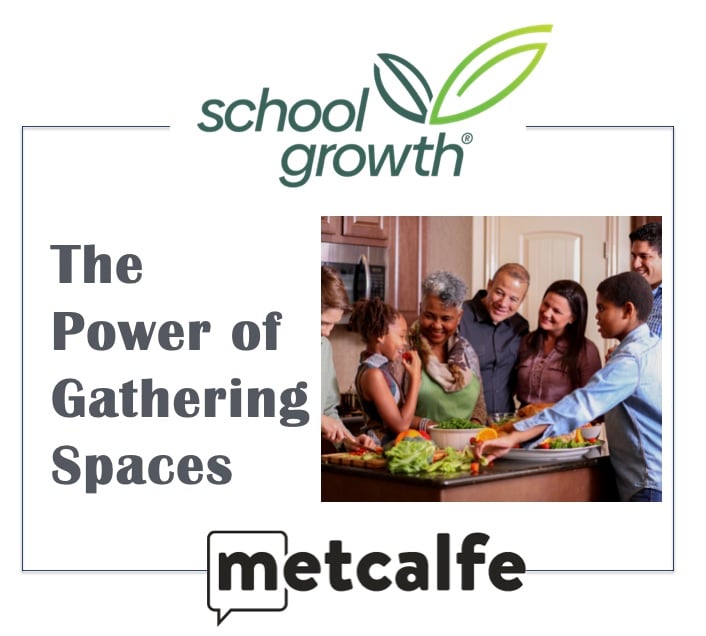
The Power of Gathering Spaces
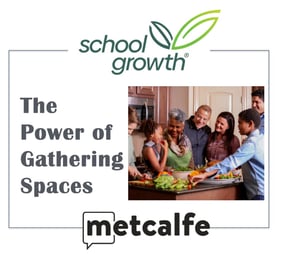 Are gathering spaces important? You bet! We know from research and from experience the close correlation between personal interactions, job performance, and cultural quality.
Are gathering spaces important? You bet! We know from research and from experience the close correlation between personal interactions, job performance, and cultural quality.
Campus spaces should be more than just a functional asset--they can become a powerful strategic tool for authentic school growth!
Think about gathering spaces in the context of our own home and the people who enjoy it. We might remember the good times with family and friends, visualizing the social spaces that host our gatherings—the family room or kitchen, and that big backyard, deck, or porch.
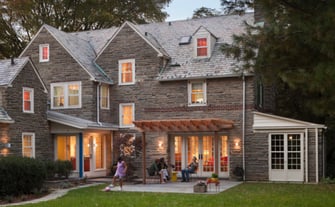 Each of these social spaces is distinctly different. We fill our family room with furniture, memorabilia and photos that mean something special to us. We can accommodate the whole family there, surrounded by the objects that make us happy.
Each of these social spaces is distinctly different. We fill our family room with furniture, memorabilia and photos that mean something special to us. We can accommodate the whole family there, surrounded by the objects that make us happy.
Maybe our dining room captures a sunset, or a long view to deer in the neighbor’s yard. A corner of the house may have a special patch of sunshine in the morning, and even though it’s not a designated “room,” we just feel happy sitting there contemplating life and thinking through the day. All these qualities are present in making powerful gathering places.
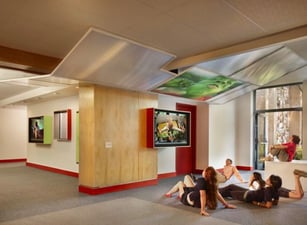 Now think about the school. Is there a place that speaks clearly to our community-- about who our school is and is becoming? Where do we greet prospective students and their families? Is there a space where the whole school can gather? What room is best suited to difficult conversations with staff or parents? Is there an intimate place that makes everyone feel most safe and comfortable?
Now think about the school. Is there a place that speaks clearly to our community-- about who our school is and is becoming? Where do we greet prospective students and their families? Is there a space where the whole school can gather? What room is best suited to difficult conversations with staff or parents? Is there an intimate place that makes everyone feel most safe and comfortable?
Some of these spaces may already exist, but how much thought went into creating them? Do they reflect our desired school culture? Do they make us happy and build trust? What about spaces that are left unused the majority of the time?
When we fail to focus on the purpose and design of a our spaces, we lose the opportunity to elevate our culture and deeper impact.
A few facts about human nature and school design:
- Face-to-face interactions are by far the most important communication activity in a school, contributing the most to building trust and engagement.
- Unplanned interactions are crucial to culture: between educators and educators, educators and students, students and students, educators and parents, parents and parents, and so on.
- Campus spaces can be designed to produce specific culture and performance outcomes.
- Investing in culturally-designed space for interactions over efficiency has been shown to consistently increase innovation and revenue.
Wise education leaders have the foresight to understand that the schools of the future are going to feature highly networked, shared, interactive gathering spaces that redefine where and how learning happens.
Creating successful gathering spaces can be tricky. Following a few design rules along the way will help you create spaces that build community and make your culture come to life.
- Be flexible—gathering places sometimes create themselves.
Watch your community. Sometimes that group of schoolgirls sitting on the hallway floor is telling you that a bump out of that same hallway would be the perfect spot for meetings and informal hangouts. Be flexible with the design of this space too. Let students move the furniture around. Invite them to make it “theirs.” If they feel like it belongs to them, they’ll use it more.
Gathering spaces should have the flexibility to be used for multiple purposes. One of our most successful design projects is the lobby of the Wissahickon Charter School. To stay on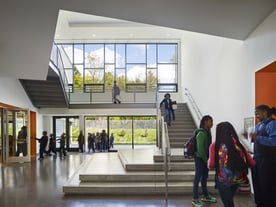 budget, the head of school sacrificed an auditorium for a much needed gym in their new building. To give them the school wide gathering space they still needed, we designed a vibrant lobby that students walk through every morning. The stairs that run through the space provide plenty of seating, while the large windows to the adjacent arboretum provide a beautiful view and reflect the school’s environmental mission.
budget, the head of school sacrificed an auditorium for a much needed gym in their new building. To give them the school wide gathering space they still needed, we designed a vibrant lobby that students walk through every morning. The stairs that run through the space provide plenty of seating, while the large windows to the adjacent arboretum provide a beautiful view and reflect the school’s environmental mission. - Create spaces sized for various ages and uses.
When designing new gathering spaces, take into consideration the ages of the people who will use them. Younger children are smaller in size and experience the world as two (or three) times as large as the educators do! For a small child, a seven-inch stair riser is more like stepping up 18 inches. A small room for 10 adults can accommodate 20 young children.
Meeting spaces in particular should be sized with that specific purpose in mind. While 10 people may feel comfortable in a room the size of a home kitchen, they would feel awkward meeting in an auditorium. - Create spaces that make people feel “safe.”
Cozy really means “safe.” Small, enclosed rooms can be wonderful spaces for intimate gatherings. Similar to the way some people always want to sit with their backs to the restaurant wall, looking at the entry door so they feel safe. - Take advantage of the outdoors.
Using principles of cozy/safe, we often create fabulous meeting places outside in creation. The “crook” of an L-shaped or U-shaped building provides a “safe” feeling while incorporating nature—a most cozy and satisfying space. - Remember that we humans are creatures of habit.
Gathering places are more successful when they are in a visible route or adjacent to a popular spot (like the cafeteria) so that our community will see them daily. When others see a gathering of people, they innately want to join in. - Finally, don’t let them know you planned it!
The best design Just “sets the table” by creating a gathering place. They’ll know what to do.
Interpretive Master Planning helps schools create gathering spaces that reflect culture and build community. To learn more how School Growth and Metcalfe elevate culture by design, visit https://www.schoolgrowth.com/metcalfe

.png?width=1000&height=199&name=SG-Logo3-Transparent-1000x199px%20(1).png)




